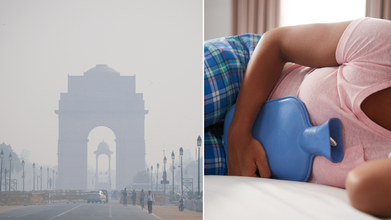- Health Conditions A-Z
- Health & Wellness
- Nutrition
- Fitness
- Health News
- Ayurveda
- Videos
- Medicine A-Z
- Parenting
What Is Blue Light? How Does It Impact Sleep?

Blue Light (Credit: Canva)
Blue light emitted by devices like smartphones, computers, and televisions is becoming a major factor disrupting our sleep cycles. Research reveals that a significant number of Americans use electronic devices close to bedtime, contributing to poor sleep quality. Reducing exposure to blue light, particularly in the evening, is a simple yet effective way to help your body prepare for restful sleep.
What Is Blue Light?
Blue light is part of the visible light spectrum and is emitted by natural and artificial sources like the sun, fluorescent lights, LED lights, and digital screens. This wavelength is known for influencing our alertness, mood, and sleep patterns. During the day, blue light plays a role in regulating circadian rhythms, helping us stay alert and focused. However, exposure to it in the evening can have a detrimental effect on sleep quality.How Does Blue Light Impact Circadian Rhythms?
Circadian rhythms are 24-hour cycles that control essential bodily functions, including sleep. Light is the primary factor that aligns these rhythms with day and night. Historically, exposure to sunlight during the day helped set our body clocks, signaling when to be awake and when to sleep. However, the widespread use of artificial lighting and electronic devices has introduced more light exposure after dark, disrupting these natural cycles.
Blue light, in particular, has the strongest impact on circadian rhythms. During daylight hours, blue light helps us feel alert by stimulating the brain, raising body temperature, and increasing heart rate. But in the evening, exposure to blue light can confuse the body’s internal clock, suppressing melatonin—the hormone responsible for making us feel sleepy. As a result, our brains may remain in “daytime mode,” preventing us from winding down for the night.
Health Consequences Of Disrupted Sleep
Persistent disruption of circadian rhythms can lead to a range of health issues, including metabolic disorders, poor mental health, and increased risk for conditions like depression and anxiety. Furthermore, the inability to sleep well at night affects cognitive performance, mood, and overall well-being. Chronic exposure to blue light in the evening may significantly contribute to these negative health outcomes.
Devices That Emit Blue Light
Many common devices in our daily lives emit blue light, including:
- Smartphones and tablets
- Computer monitors and laptops
- Televisions and e-readers
- LED and fluorescent lighting
- Video game consoles
How To Minimize Blue Light Exposure
To reduce the effects of blue light on your sleep, here are some practical strategies:
1. Turn off screens before bed: Try to avoid using electronic devices at least two to three hours before bedtime. Reducing screen time helps prevent blue light from interfering with melatonin production.
2. Adjust your lighting: Dim your home’s lights or switch to warmer-toned lighting in the evening. You can also use lamps with red or orange light, which are less likely to impact your circadian rhythms.
3. Night mode settings: Many smartphones and computers have a "night mode" feature that reduces blue light emission. Make use of these features to limit exposure in the hours leading up to bedtime.
4. Blue light-blocking glasses: Special glasses designed to filter out blue light may be helpful for some individuals. These glasses can block or reduce the melatonin-suppressing effects of blue light.
5. Apps for blue light reduction: There are several smartphone and computer apps available that reduce blue light emission, allowing you to use your devices before bed without disturbing your sleep.
6. Create a sleep-friendly environment: If you can’t control light sources in your bedroom, consider using an eye mask to block out ambient light and promote better sleep.
Rabies Pre-Exposure Prophylaxis Vaccine Can Protect You Even Before A Dog Bite—Here’s How

Credits: Canva
Rabies is a fatal viral disease that spreads to humans through the saliva of infected animals. It targets the central nervous system, and nearly 99 percent of human cases are linked to infected dogs. A recent *Lancet* study found that about 5,726 people still die from rabies each year, even though overall deaths have declined over time. This is why prompt medical care after a dog bite or scratch is critical. Most people believe the rabies vaccine taken after a bite is enough. What many do not realise is that a pre-exposure prophylaxis vaccine is also available and can be taken even before a bite occurs. So why does this vaccine matter, and how does it actually protect you?
What Is A Rabies Pre Exposure Prophylaxis Vaccine?
A rabies pre-exposure prophylaxis, or PrEP, vaccine involves a set of shots given before any possible contact with the rabies virus. It is mainly recommended for people at higher risk, such as veterinarians, animal handlers, laboratory workers, and travellers visiting regions where rabies is common. While PrEP does not remove the need for treatment after a bite, it makes post-exposure care simpler. People who have received PrEP need fewer follow-up injections and do not require rabies immunoglobulin, which can be hard to access in emergencies and may save crucial time.
How Can Rabies Pre Exposure Prophylaxis Vaccine Protect You?
According to Dr Deepa Aggarwal, who shared insights on her Instagram account, the rabies pre-exposure prophylaxis vaccine prepares the immune system in advance. It helps the body develop antibodies before any exposure occurs. If a vaccinated person is bitten later, they need only two booster shots and no immunoglobulin. The immune response is quicker, lowering the risk of the virus spreading to the brain. This is especially important for people at high risk or in situations where medical treatment may be delayed.
Rabies Pre Exposure Prophylaxis Vaccine: How It Works?
- Introduces Antigens: The vaccine contains an inactivated form of the rabies virus, which safely exposes the body to its antigens.
- Builds Memory: The immune system learns to recognise these antigens and creates antibodies along with memory cells.
- Rapid Response on Exposure: If exposure happens later, these memory cells act fast, producing antibodies that stop the virus before it can cause infection.
CDC Guidelines On Rabies Pre Exposure Prophylaxis Vaccine
The Advisory Committee on Immunization Practices, or ACIP, has updated its recommendations for rabies PrEP.
- A two-dose PrEP schedule has now replaced the earlier three-dose schedule and offers protection for up to three years. Options for maintaining protection beyond three years are also outlined on their website.
- The minimum antibody level used to decide whether a booster is needed has been revised and standardised.
- Many people who previously needed antibody testing every two years now require only a one-time titer check, followed by a booster if levels are low, or in some cases, just a one-time booster.
Who Should Get The Rabies Pre Exposure Prophylaxis Vaccine?
While the vaccine can benefit anyone, rabies pre-exposure prophylaxis is mainly advised for people with frequent or high risk of exposure. This includes veterinarians, animal handlers, wildlife workers, laboratory staff, and travellers to areas where rabies is widespread. The vaccine makes treatment after a bite easier by reducing the number of shots required. However, health authorities stress that while PrEP offers protection, it does not replace full post-exposure treatment after a confirmed bite, as advised by the CDC and WHO.
Is Delhi's Toxic Air Making Your Period Cramps More Painful? Here's What Study Says

Credits: iStock
Air quality in Delhi remains toxic, despite the GRAP !V measures implemented in the national capital. Today, Delhi recorded an AQI of 358, this remains under 'very poor'. As per the Central Pollution Control Board (CPCB), the AQI was recorded at 442 in Ghazipur, 409 in ITO, and 447 in Palam, all under 'severe' category.
While we have long known that pollution impacts lung and respiratory health, but it can impact beyond that, including causing severe menstrual cramps.
What Proves That Air Pollution Impacts Menstrual Cramps?
A study published in Frontiers in Public Health, explored the data of 2,96,078 women and girls between the age of 16 to 55 years in Taiwan and correlated it with the long-term air pollution data between 2000 and 2013. None of these women had any history of dysmenorrhea before the survey had began. Dysmenorrhea is a common gynaecological condition that impacts 16 to 91% of people in their reproductive age. The signs and symptoms include painful and severe periods that are results of hormonal imbalances.
The results showed that during the 13 years, 4.2% women and girls were diagnosed with dysmenorrhea for the first time. The study concluded that risk of developing dysmenorrhea was up to 33 times higher among women and girls who lived in areas with the highest levels of air pollutants.
Professor Hsu, who conducted the study said, "Our results demonstrate the major impact of the quality of air on human health in general, here specifically on the risk of dysmenorrhea in women and girls."
The pollutants in questions are nitrogen oxide, nitric oxide, nitrogen dioxide, carbon monoxide, and particle smaller than 2.5 µm in diameter (PM2.5).
How Air Pollution Shapes Menstrual Health - Its Impact
The public health impact of air pollution is more layered and gendered than it often appears. Over the years, a growing body of research has begun to link polluted air with menstrual health problems. A 2018 study found that teenage girls exposed to higher air pollution were more likely to experience irregular periods and took longer to develop regular cycles during adolescence and early adulthood. Other studies have connected air pollution with longer menstrual cycles, increased stress, reproductive health issues, and even changes observed during lockdown periods. Conditions such as infertility, metabolic syndrome, and polycystic ovary syndrome have also been associated with prolonged exposure to polluted air.
These findings challenge the idea that menstrual health is purely biological. Instead, it is deeply influenced by social and environmental conditions, including income levels and where a person lives. In the present study, researchers observed that younger women, women from lower-income backgrounds, and those living in highly urbanised areas faced a higher risk of developing dysmenorrhea or painful periods. Among all factors studied, long-term exposure to high levels of PM2.5 emerged as the strongest contributor. PM2.5 refers to fine, inhalable particles commonly found in polluted air that can penetrate deep into the body.
The concern becomes sharper in the Indian context. In 2019, India recorded the highest PM2.5 levels globally. The study highlights clear differences in menstrual experiences between women and girls living in urban versus rural areas. Those in low-income and densely populated urban regions, where exposure to air pollution is often highest, showed a significantly greater risk of dysmenorrhea.
This health burden is further compounded by period poverty, which continues to affect large sections of rural India and many other countries. Limited access to sanitary products, lack of awareness, and social stigma mean that many girls and women already miss school and work during their periods. Increased menstrual pain linked to environmental factors like air pollution only deepens these challenges.
A 2017 study underlined the importance of identifying environmental influences on the menstrual cycle from a public health perspective, noting potential long-term consequences such as infertility, reproductive cancers, osteoporosis, and metabolic disorders.
Using An Air Purifier At Home? Pulmonologist Warns These 5 Common Mistakes Could Put Your Lungs At Risk

Credits: Canva
With winter setting in, Delhi and the NCR are once again dealing with a sharp rise in air pollution, with AQI levels often slipping into the “very unhealthy” category. Hazy mornings, dense smog, and a steady increase in breathing problems have made clean air feel out of reach for many residents. As a result, people are relying more on air purifiers indoors and masks outdoors.
Still, not everyone knows how to use these measures correctly. We spoke to pulmonologist Dr. Vijay Kumar Agrawal, Director of Pulmonology and Critical Care at Yatharth Super Speciality Hospital, Faridabad, who shared a few important points that can help protect your lungs even inside your home.
What Is An Air Purifier?
An air purifier is a device designed to improve indoor air quality by filtering out pollutants such as dust, pollen, pet hair, smoke, and mold spores. It works by pulling air through filters like HEPA or activated carbon, or by using certain technologies, and then releasing cleaner air back into the room.
This process can help reduce triggers for allergies and asthma and make breathing easier. While air purifiers are particularly helpful for people with respiratory conditions, growing pollution levels have made them a common household choice even among otherwise healthy individuals. That said, simply owning an air purifier is not enough. There are a few key things you should keep in mind while using one.
Select Air Purifier With HEPA Filter Only
Dr. Agrawal advises choosing an air purifier that uses a HEPA filter. Many people unknowingly use air purifier that release ozone or free radicals, which can increase the risk of breathing problems, irritation, coughing, and shortness of breath. According to him, “Air purifiers with HEPA filters are ozone-free and safer because they do not emit harmful particles or ozone into the air.”
Always Maintain An Ideal Indoor Humidity Level- 40-50%
To reduce the impact of viruses, indoor pollutants, and dryness on the body, it is best to maintain indoor relative humidity between about 40% and 60%. Dr. Agrawal explains that excessive use of air purifiers can lower humidity levels indoors, leading to dryness. “Low humidity can irritate the airways and may worsen respiratory issues,” he says.
Keep Your Air Purifier 2-6 ft Away From You
Experts recommend keeping an air purifier at a distance of around 2 to 6 feet from where you sit or sleep. Placing it within this range helps clean the air more effectively in your breathing zone, especially in spaces like bedrooms or offices. Dr. Agrawal notes, “Keeping the air purifier at an appropriate distance helps reduce PM2.5 and PM10 levels, along with other particles such as pollen, mold spores, and certain bacteria around us.”
Dont Burn Incense Sticks And Mosquito Coils With An Air Purifier In The Room
In many Indian households, burning incense sticks or mosquito coils indoors is common. However, these release chemical irritants that can be harmful to the lungs. Using them in the same room as an air purifier defeats the purpose of cleaner air and should be avoided.
Dont Tightly Close Windows And Doors
Proper ventilation is still important, even when using an air purifier. Dr. Agrawal recommends keeping at least one window or a small door slightly open to allow fresh air exchange. This helps ensure a supply of oxygen from outside and prevents indoor air from becoming stale.
Dr. Agrawal adds that while using an air purifier is generally safe and even long-term use is not harmful, following these precautions is essential to truly protect your lungs and maintain healthier air indoors.
© 2024 Bennett, Coleman & Company Limited

